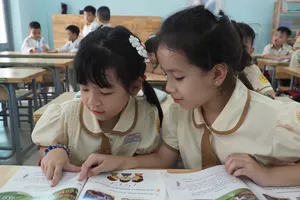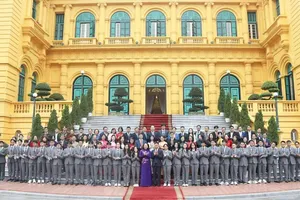When communities move as one
At the end of August, as the mountain rains subsided, construction began on the Tay Giang Ethnic Minority Boarding Primary and Secondary School in Da Nang City. Spanning over 5 hectares with a total investment of VND262 billion, the project is scheduled for completion by the 2026–2027 academic year. It is one of six new schools approved for construction in Da Nang this year.

According to Vice Chairman Tran Anh Tuan of Da Nang City People’s Committee, the city was able to commence the project just weeks after completing administrative procedures, a source of pride and a weighty responsibility in the nation-building mission of education.
Alongside educational infrastructure, Da Nang is investing in grassroots healthcare, transportation, and small-scale green industry clusters linked to agriculture to create livelihoods and employment opportunities for local people ensuring that graduates can find stable work in their own hometowns.
In Lai Chau Province, local authorities actively reviewed needs across 11 border communes. As a result, the Ministry of Public Security approved funding for two boarding schools in Pa Tan and Bum Nua communes.
Speaking at the groundbreaking ceremony, Senior Lieutenant General Nguyen Van Long, Deputy Minister of Public Security, said: “To build these two inter-level boarding schools, dozens of households willingly handed over forest land. Village elders and community leaders worked tirelessly to ensure rapid site clearance. Once completed, the schools will provide better learning environments for children while contributing to national defense, security, and socio-economic development.”
Each school, built with an investment of VND200 billion, will include 30 classrooms, functional rooms, dormitories for teachers and students, and sports facilities serving around 1,000 students.
Further south in the Central Highlands, residents of Buon Don Commune in Dak Lak Province are equally excited about their new school. As her daughter eagerly walks to class, HRan, a local mother, can't hold back tears. “All my life I’ve worked hard just to see my child get a proper education,” she says proudly, adding that she has already agreed to hand over her land for the school project.
Vice Chairwoman of Buon Don Commune People’s Committee Tran Thi Thuy noted that the 5.8-hectare project affects 12 households, all of whom have shown strong support and readiness to contribute their land for the school.
Resources are prepared for integration
Beyond physical infrastructure, education sectors in many border provinces are proactively preparing human resources by training administrators and teachers — particularly in digital literacy and artificial intelligence (AI). Hoang Tuyet Ban, Director of the Dien Bien Department of Education and Training, said the department has partnered with the U.S.-based non-profit organization STEAM for Vietnam to launch the “Train the Trainers 2025 – AI for Dien Bien Teachers” project. The initiative aims to train about 17,000 educators in AI and related technologies to help integrate them into teaching practices.
In Cao Bang, Deputy Director of the Department of Education and Training Dam Thi Trung Thu emphasized building new schools is important, but even more crucial is nurturing students who are not only academically capable but also culturally grounded and connected to their homeland.
The province has developed plans to assign skilled management and teaching staff to 10 new boarding schools in 21 border communes this year, while organizing workshops and training sessions on implementing the 2018 National Education Curriculum.
To ensure a sustainable supply of qualified teachers, Associate Professor Nguyen Van Nam, Vice Rector of Tay Nguyen University, shared that the Faculty of Education currently offers five teaching majors and two non-teaching programs, enrolling 1,604 students. The faculty continues to enhance training quality, with the 2024–2025 school year recording 13.89 percent of students achieving excellent standing, 18.22 percent rated good academic performance and 40.18 percent assessed as fair.
Over 93 percent achieved good or excellent conduct evaluations. Graduates are now well-prepared to meet the teaching needs of provinces such as Dak Lak, Gia Lai, and Lam Dong particularly in newly built boarding and semi-boarding schools across border areas.
Border guards support teachers and students in mountainous regions
Alongside the efforts of the local authorities and the education sector, the armed forces have become an indispensable companion in the journey of bringing education to border areas. In a combined effort from forces under the Ministry of National Defence through the project, "Army Officers and Soldiers Support Children on their Path to School," in which the Border Guard Command plays a core role, they have assisted over 21,000 disadvantaged ethnic minority students.
Of these students, 1,600 children are directly cared for and nurtured at military units to ensure they maintain regular attendance and do not drop out. Many of them have achieved high results in competitions, earning commendations as good and excellent students. Over the past four years, Border Guard units in various provinces have disbursed VND126 billion to support students and arranged accommodation for 5,837 children. In 2025, 40 units directly under the Ministry of National Defence will continue to take in 400 children and commit to supporting 5,437 ethnic minority children.
Colonel Vu Quoc An, Deputy Political Commissar of the Border Guard Command under the Ministry of National Defence, emphasized that while policies and support mechanisms for children and students in ethnic minority, mountainous, and particularly disadvantaged regions are being effectively implemented, many still face challenging circumstances and remain at risk of dropping out. He underscored the need for sustained attention, comprehensive support, and the creation of favorable conditions to ensure that these students can continue their education, pursue learning, and achieve personal development.
























